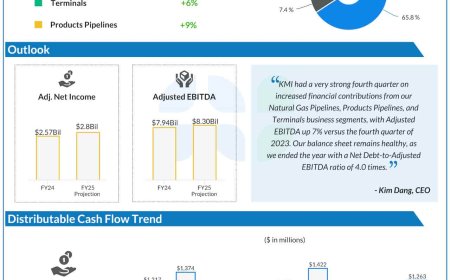The Essential Guide to Choosing the Right Route Software for Your Business
Delivering exceptional customer experiences hinges on one critical factor: efficient logistics. For enterprises navigating the complexities of the retail, apparel, and furniture industry, the quest for timely and reliable deliveries is more important than ever. As consumer expectations soar, the pressure to provide faster, smarter, and more sustainable delivery solutions intensifies. In this case, choosing […] The post The Essential Guide to Choosing the Right Route Software for Your Business appeared first on Insights Success.

Delivering exceptional customer experiences hinges on one critical factor: efficient logistics. For enterprises navigating the complexities of the retail, apparel, and furniture industry, the quest for timely and reliable deliveries is more important than ever.
As consumer expectations soar, the pressure to provide faster, smarter, and more sustainable delivery solutions intensifies. In this case, choosing the right route software is not just a strategic decision; it’s an essential step toward future-proofing your operations.
Understanding Route Software and Its Benefits
Route software is designed to simplify the planning and execution of delivery routes. It allows dispatchers to automate the order allocation process, resulting in faster and more efficient operations.
By leveraging advanced algorithms, route software can solve complex logistical constraints—up to 100 at a time—much more efficiently than manual methods. This capability is particularly valuable for businesses that handle bulk orders, as it reduces the time for order allocation to just 30 minutes.
With features like AI-driven insights, precise geocoding, and dynamic routing, route software addresses key challenges such as high delivery costs, capacity and shift utilization, inefficiency, and sustainability. By planning for high volumes and adapting to congestion and dynamic changes, route software becomes a vital tool for modern enterprises.
Key Considerations When Choosing Route Software
1. Scalability and Flexibility
As your business grows, so will your delivery needs. When selecting route software, consider a solution that can scale with your business. Look for software that can handle increased order volumes and adapt to changing delivery requirements. A flexible platform allows your dispatchers to manage diverse orders efficiently, making it easier to meet customer demands.
2. User-Friendly Interface
An intuitive user interface is essential for ensuring that your team can adopt the software quickly. Complex systems can lead to confusion and inefficiency. Look for route software that features a clear and easy-to-navigate interface, allowing dispatchers to plan routes with minimal training. This ease of use can lead to quicker implementation and faster results.
3. Real-Time Tracking and Updates
Today’s customers expect transparency in their delivery processes. Choose route software that offers real-time tracking capabilities. This feature not only allows customers to see the status of their deliveries but also enables dispatchers to adjust routes on the fly. Whether there’s a traffic delay or a last-minute order, real-time updates ensure that your deliveries remain on schedule.
4. Integration with Existing Systems
Your route software should seamlessly integrate with your existing logistics and management systems. Whether it’s inventory management, customer relationship management (CRM), or order processing platforms, compatibility is crucial. This integration ensures a smooth flow of information and reduces the chances of errors due to data discrepancies.
5. Cost-Effectiveness
While investing in route software can initially seem like a significant expense, consider the long-term savings it can provide. Efficient route planning reduces fuel costs, decreases labor expenses, and minimizes vehicle wear and tear. Analyze the total cost of ownership, including subscription fees, implementation costs, and potential savings, to determine the best value for your business.
Evaluating Software Features
When exploring route software, pay close attention to specific features that align with your business needs. Here are some essential features to look for:
1. Dynamic Routing
Dynamic routing capabilities allow for real-time adjustments to delivery plans based on current conditions. This feature is crucial in industries like retail and furniture, where timely deliveries can significantly impact customer satisfaction and business reputation. Dynamic routing should ensure compliance with the regulations set forth by the Department of Transportation (DOT), helping you avoid fines and adhere to legal parameters.
Additionally, the software must incorporate updates on road closures, enabling dispatchers to quickly reroute deliveries to minimize delays. Real-time access to weather conditions is also vital, as it allows dispatchers to proactively adjust routes in anticipation of adverse weather, maintaining timely deliveries and enhancing overall efficiency. By integrating these elements, dynamic routing optimizes delivery efficiency and sustainability, ensuring that dispatchers can respond swiftly to changing circumstances.
2. Smart Geocoding
Enhancing address accuracy through machine learning (ML) and deep data learning techniques helps delivery stakeholders locate customers with precision. Effective geocoding reduces first-attempt failures and minimizes fuel consumption, thereby boosting profit margins per delivery.
By leveraging comprehensive datasets, enterprises can improve address validation and standardization, significantly reducing errors in delivery locations. The ability to analyze customer address patterns can also identify areas with frequent delivery issues, allowing businesses to implement targeted strategies for improvement. With these capabilities, effective geocoding significantly enhances the overall delivery process.
3. Load Optimization
Efficient load optimization is vital for managing bulk orders, particularly in sectors like apparel and furniture. Route software should automatically calculate the best way to load vehicles, ensuring that capacity is maximized without compromising safety or delivery timelines.
In this context, handling Less than Truckload (LTL) shipments effectively allows for resource-efficient routing of multiple smaller deliveries, while Full Truckload (FTL) management optimizes routes for full loads by considering weight distribution and vehicle capacity.
Furthermore, multi-day routing capabilities enable planning that accommodates complex deliveries over several days, ensuring that drivers can meet scheduled commitments effectively. By optimizing routing data such as traffic, delivery priorities, and vehicle capacities, businesses can predict vehicle loads before delivery, potentially reducing delivery routes.
4. AI-Driven Insights
Utilizing AI-driven insights empowers businesses to adjust vehicle counts, make working time modifications based on demand patterns, and explore different vehicle types. This approach can maximize productivity while ensuring efficient resource utilization. Within this framework, analyzing driver performance is crucial to uncover inefficiencies in the delivery process.
By monitoring key metrics, businesses can provide targeted training and coaching to enhance driver efficiency. Additionally, AI insights can identify opportunities to reduce empty backhauls by suggesting return loads for vehicles, maximizing vehicle utilization, and minimizing unnecessary costs. Real-time task allocation further streamlines operations by automating assignments for drivers, optimizing delivery slots, and reducing transit times.
5. Analytics and Reporting
Data-driven decision-making is essential for optimizing delivery processes. Choosing route software that provides comprehensive analytics and reporting features is vital. This capability allows businesses to analyze performance metrics, helping to gauge the effectiveness of delivery operations.
By identifying bottlenecks in the supply chain, enterprises can make informed adjustments to their logistics strategies. Additionally, robust analytics ensure compliance with transportation regulations, helping to avoid potential pitfalls and penalties. With access to real-time data, businesses can make strategic decisions that enhance operational efficiency.
6. Green-Fleet Routing
Integrating sustainable vehicles, such as electric vehicles (EVs), into your fleet is crucial for enhancing sustainability. The route software should factor in charging stations, allowing for optimized routes based on charging needs, which ensures that EVs can complete deliveries without running out of power.
An essential component of green fleet routing is dynamic slot selection. This feature enables businesses to optimize delivery windows based on real-time traffic data and environmental considerations. By utilizing AI algorithms, enterprises can identify and assign the most suitable time slots for deliveries, taking into account factors such as road congestion and vehicle emissions.
Implementation and Training
Once you’ve chosen the right route software, effective implementation becomes a critical factor in realizing its full potential. The first step is to create a structured implementation plan that outlines timelines, responsibilities, and key performance indicators (KPIs) to measure success. This plan should include a detailed assessment of your existing processes to identify areas where the new software can make a significant impact.
Training your team is paramount. Ensure that all relevant staff members receive thorough training on how to use the software effectively. This training should encompass not only the technical aspects, such as how to input data and generate reports but also best practices for optimizing routes and managing unexpected challenges. For instance, your team should be well-versed in using dynamic routing features to adjust deliveries in real-time, as well as smart geocoding for accurate address validation.
The Future of Route Optimization
As technology continues to evolve at a rapid pace, so does the landscape of route optimization. Innovations in artificial intelligence (AI), machine learning (ML), and advanced analytics are revolutionizing the logistics industry. These technologies are enabling businesses to gain deeper insights into their operations and customer behaviors, thus facilitating more informed decision-making.
AI-driven solutions are becoming increasingly sophisticated, allowing enterprises to analyze vast amounts of data quickly. This capability empowers companies to optimize routes based on real-time conditions, reducing delivery times and enhancing overall efficiency. Moreover, predictive analytics can forecast demand patterns, enabling businesses to allocate resources more effectively and avoid underutilization of their fleets.
Finding the Right Partner for Your Delivery Needs
Choosing the right route software is an essential step in transforming your delivery processes. With the right solution, enterprises can achieve greater efficiency, enhance customer satisfaction, and reduce operational costs. As you evaluate options, consider factors such as scalability, user-friendliness, and integration capabilities.
While many providers offer routing solutions, technology partners like FarEye stand out as a leader in optimizing delivery logistics. With features tailored to industries like retail, apparel, and furniture, they empower enterprises to navigate complex routing challenges effortlessly.
The post The Essential Guide to Choosing the Right Route Software for Your Business appeared first on Insights Success.











































